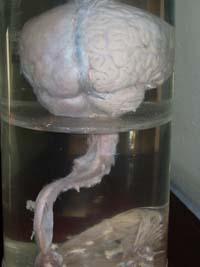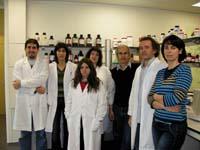New destinations for neurodegenerative diseases

UPV researchers investigate erroneous signals in the central nervous system, specifically in the brain and spinal cord. That is, they investigate the signals that cause the death of cells of the central nervous system.
In the central nervous system there are mainly two types of cells: neurons and glial cells. Both types of cells are very sensitive to any failure in the central nervous system and can die. In the case of Alzheimer's disease, for example, the death of neurons occurs. In the case of multiple sclerosis, some types of glial cells, oligodendrocytes, die.
From in vitro cells to biological samples
Researchers from the neurobiological laboratory analyze neurons, oligodendrocytes, or other cells of the nervous system in cultures. In cultures, it is a matter of simulating relevant facts or conditions in these diseases. In this way, they cause the death of these cells, identifying the molecules involved in this process, from the moment the lethal signal is emitted to the death of the cells. In addition, they try to find drugs that can improve the treatment of these diseases.
In addition to working in vitro, they also work with experimental animals. These animals simulate in some way the most representative elements of these diseases, causing sensory symptoms, motors, etc. The substances that have aroused a certain in vitro interest then observe whether or not they have the same influence on these experimental models.
In addition, in recent years they have had the opportunity to analyze brain samples of people who have died from neurodegenerative diseases such as multiple sclerosis. Despite the final point, these diseases leave a mark on these samples. Researchers see if there is any alteration in the molecules studied in cells or animals (or similar). Thus, they check whether the molecular targets found experimentally are important or not for neurodegenerative processes. If so, they try to develop drugs that help stop cell death.
In collaboration with several neurologists, they can also analyze other biological samples, such as blood, as long as patients give their consent for the sample to be studied. In fact, certain alterations that can be observed in the blood plasma are indicators of something happening in the brain.

In search of effective drugs
All of these experiments are a dynamic process that helps researchers find drug tracks that can help disrupt or at least slow the evolution of neurodegenerative diseases. On the one hand, they seek the molecular targets of drugs and, on the other, they seek substances that facilitate the survival of neurons and oligodendrocytes such as antioxidants. In many neurodegenerative diseases, cells die from oxidative stress.
In recent years, researchers at the Neurobiology laboratory have discovered a series of antioxidants that slow down or mitigate the death process and are also able to protect neurons. They are antioxidants of natural origin that can be found in the diet, in fruits, vegetables, etc. They seem to mitigate the damage caused by these diseases.
In short, the objective of the UPV/EHU researchers is to know better the molecular bases of these pathologies, define the therapeutic goals and, finally, find drugs that can help improve their treatment.






